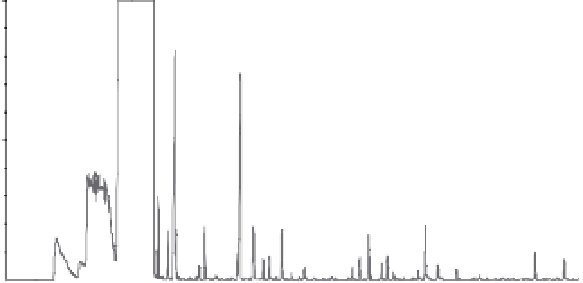Agriculture Reference
In-Depth Information
Alcohols:
Aldehydes and ketones:
Linalool (4)
Octanal
Octanol (3)
Decanal (6)
α
-Terpineol (5)
Acetaldehyde
Terpenes:
Carvone
Valencene (8)
Perillyldehyde
Myrcene (2)
β
-Sinensal (9)
Caryophellene (7)
Organic acids:
α
-Pinene (1)
Acetic
Esters:
Caprylic
Ethyl butyrate
n-Octyl acetate
Ethyl isovalerate
100
4
6
50
2
3
1
9
5
7
0
10.5
12.5
14.5
16.5
18.5
20.5
22.5
24.5
26.5
28.5
Time
Figure 21.4.
Some characteristic volatile compounds in orange oil and typical gas chromatogram with some
of the aroma compounds identified.
SSC of 10.5
◦
Brix (21 Code of Federal Regulations [CFR]
146.140) and canned mandate a minimum of 10
◦
Brix (21
CFR 146.141). However, the USDA standards for “Grade A
pasteurized” and “Grade A from concentrate” orange juice
mandate 11
◦
Brix and 11.8
◦
Brix, respectively. The USDA
establishes minimum scores for color (40), defects (20), and
flavor (40) factors and a minimal total score for each grade.
The European Union regulates the addition of sugar (up to
15 g/liter) and lemon juice (up to 3 g/liter as citric acid).
Processing
found in several volumes elsewhere (Praschan, 1975; Redd
et al., 1992, 1996; Braddock, 1999a; Kimball, 1999a).
Handling for processing
Oranges are transported to processing plants in 20,000 kg
(500 90-lb boxes) trucks. Each full truck load is assigned
a ticket and unloaded by inclining it on a hydraulic plat-
form that lifts and inclines the whole truck or by driving the
truck onto a ramp. Trucks are weighed before and after un-
loading. In the state of Florida, by regulation a statistically
representative sample of each truckload is taken and ana-
lyzed for juice yield, SSC, TA reported as citric acid, and
the SSC/TA ratio. These analyses are carried out by a third
party authorized by the Florida Department of Agriculture
and Consumer Services, ensuring that processors pay a fair
price for the quality of the fruit purchased. The price paid
to the grower in the United States per load is based on the
total amount of soluble solids content and not on the basis
of juice yield only. Prices in dollars per pound of solids
are negotiated and paid based on contracts. In Florida some
(thermal)
affects
mostly
vitamin
C,
α
-
carotene,
-cryptoxanthin, and vitamin A.
Other vitamins as well as carbohydrates, lipids, amino acids
and minerals are not significantly affected by processing.
Juices enriched with calcium and vitamin D obviously have
increased concentrations of these compounds and, accord-
ing to FDA regulations, must be stated on the label.
β
-carotene,
β
PROCESSING AND PROCESSED PRODUCTS
In-depth description and discussion of citrus processing
technology is beyond the scope of this chapter but can be


Search WWH ::

Custom Search